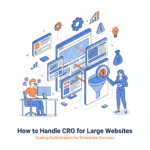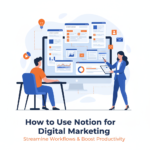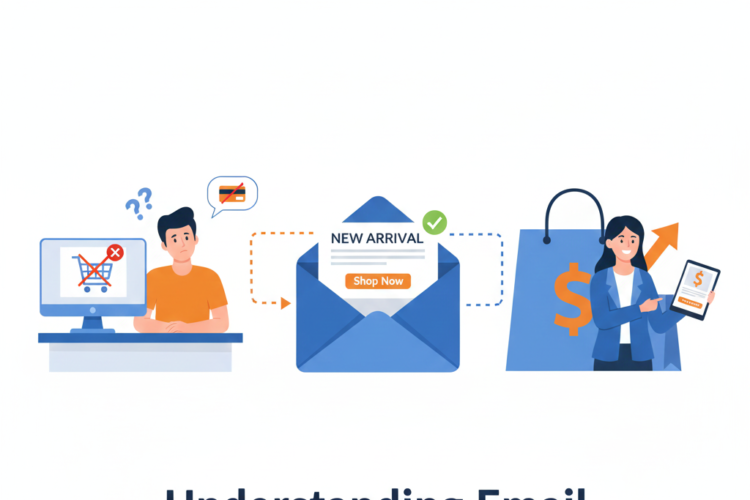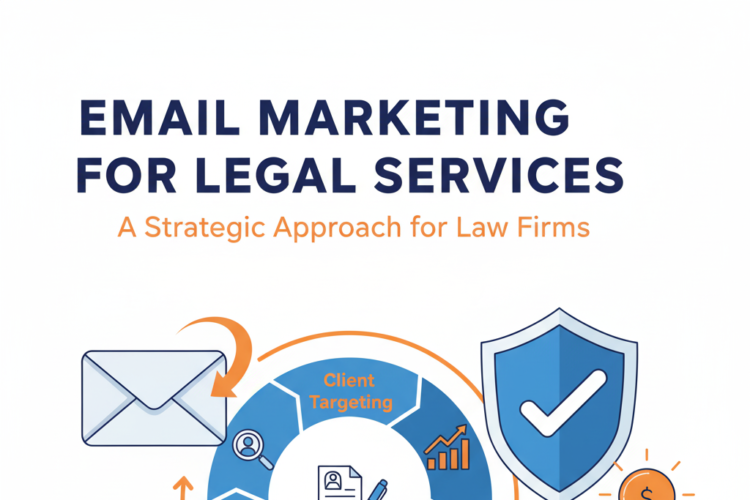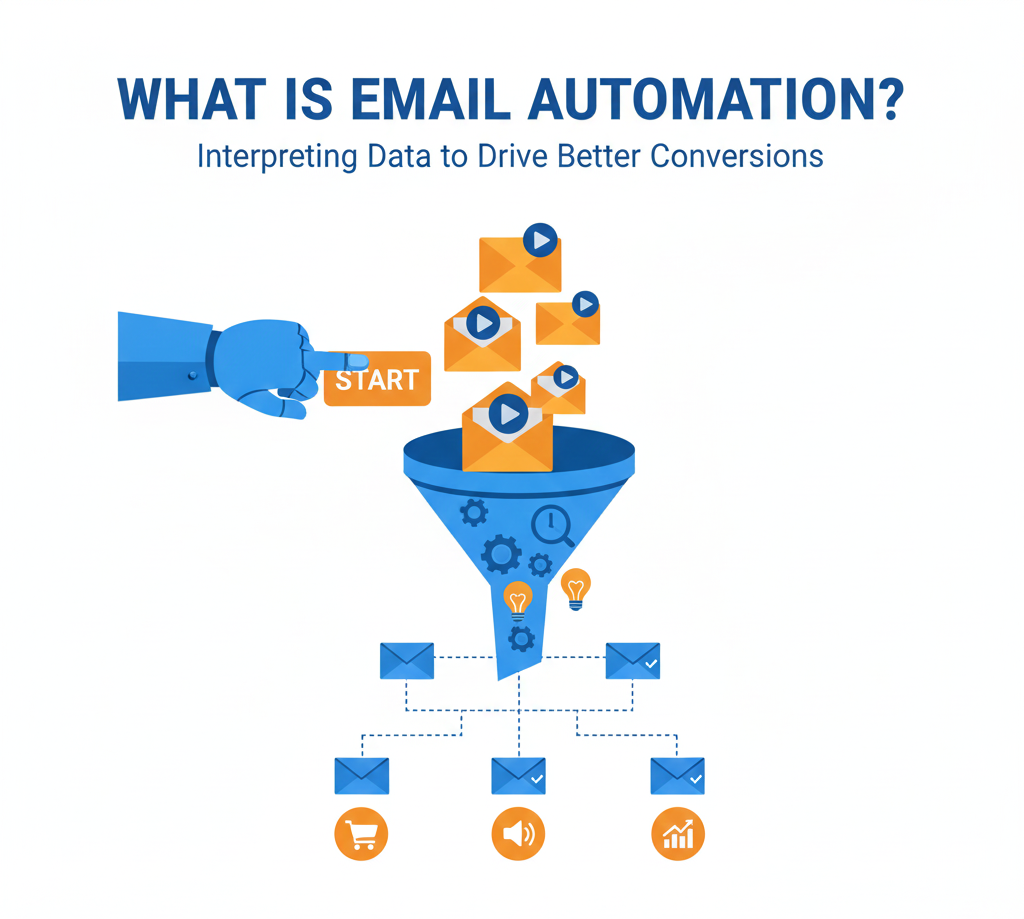
Email automation
1) Short definition (one-liner)
Email automation is the practice of using software to automatically send targeted, pre-determined email messages to people based on triggers, schedules, or user behavior — enabling personalization and scale without manual sending.
2) How email automation works — technical architecture & flow (step-by-step)
Data collection / event trigger
When a user takes an action (signs up, views a product, adds to cart), the website/app records an event.
Events are captured via JavaScript tags (through an ESP snippet or Google Tag Manager), server-side tracking, or API calls from your backend.
Event ingestion & identity resolution
Events are sent to your Email Service Provider (ESP) or Customer Data Platform (CDP).
The system links events to a user identity (email, user ID, cookie, hashed phone number) — this is identity resolution.
Audience & rule evaluation
The automation engine evaluates rules you defined (e.g., “if user added to cart and didn’t purchase in 24 hours → add to ‘cart abandoners’ list”).
Workflow / orchestration engine
A visual workflow or code-defined flow runs: waits, branches, checks conditions, sends messages, or performs API actions (e.g., update CRM).
Email creation and rendering
Template engine injects personalization tokens, dynamic content (product image, price), and generates final HTML + text version.
Sending
Emails go out via the ESP’s sending infrastructure or through an external SMTP/relay (Postmark, Amazon SES, Sendgrid).
Transactional vs marketing separation often uses different sending domains/IPs.
Tracking and reporting
Opens, clicks, bounces, unsubscribes, conversions are tracked via tracking pixels, click redirects, event callbacks, or server-side confirmations.
Follow-up actions
Based on responses, the user may be moved to a new segment, receive next emails, or be excluded (e.g., if they converted).
3) Typical triggers — what causes an automated email to send
(Each trigger can have many variants and rules.)
Behavioral triggers
Page viewed (e.g., product page)
Add-to-cart but no purchase
Browse abandonment (view category but no item)
Downloaded resource
Video watched / webinar attended
Link clicked in a previous email
Transactional triggers
Purchase confirmation / invoice
Shipping/fulfillment updates
Password reset
Account creation / activation
Time-based triggers
Welcome series after signup (e.g., immediately → day 3 → day 7)
Drip sequences (education series)
Renewal reminders (30/7/1 days before expiry)
Anniversary/birthday emails
CRM/behavioral data triggers
Lead score crosses threshold
Customer reaches certain lifetime spend (RFM events)
Support ticket resolution
External webhooks / API triggers
Payment failed webhook → send dunning email
CRM stage changed → send handoff email
4) Core components of an automated workflow (what to configure)
Entry condition(s) — who enters this flow (e.g.,
signup = trueorcart_value > ₹2000).Delay / wait steps — define exact wait times (e.g., wait 6 hours, then send).
Branching / conditional logic — if/else routes: did they open? did they purchase?
Exit conditions — when to remove the user from the flow (purchase, unsubscribe, blacklist).
Frequency control — throttle how often a person can receive messages (frequency caps).
Suppression lists — global unsubscribe, do-not-email lists, bounced addresses.
Personalization tokens / dynamic blocks —
{{first_name}},{{product_name}}, or conditional content blocks.Logging & notifications — log events to analytics/CRM and notify sales if lead qualifies.
5) Segmentation & personalization — the heart of relevance
Segmentation types
Demographic (age, gender, location)
Behavioral (pages visited, purchases, opened previous emails)
Value-based (RFM: Recency, Frequency, Monetary)
Lifecycle stage (subscriber, trial user, active customer, churn risk)
Engagement (highly engaged, inactive, lapsed)
Personalization techniques
Merge tags:
Hi {{first_name}}Dynamic product blocks: pull top 3 recommended products from product feed
Conditional content: show one block if user in India, else another
Personalized subject lines: include recent viewed product
Still thinking about {{product_name}}?Smart recommendations: “People like you also bought…” using collaborative filtering
Time zone send: deliver in recipient’s local morning
Why it matters
Personalized emails dramatically increase open rates, CTR, conversion, and reduce unsubscribes.
6) Types of automated emails — what they are and best practices
I’ll explain each type and include a short template idea.
A. Welcome / Onboarding Series
Goal: Introduce brand, set expectations, get first conversion or deeper engagement.
Structure: 3–5 emails over 1–14 days (immediate welcome, brand story/benefits, social proof + offer, tips/FAQ).
Best practices: Use clear CTA, deliver promised lead magnet, set preferences.
Sample subject lines: “Welcome — Here’s your 10% off”, “How to get started with X in 3 minutes”
Template (first welcome):
Subject: Welcome to {{brand}} — here’s your 10% off
Hi {{first_name}},Thanks for joining {{brand}}. As promised, here’s your code: WELCOME10
Quick start:
1) Shop bestsellers: [link]
2) See how it works: [video]
3) Need help? Reply to this email.— Team {{brand}}
B. Abandoned Cart Recovery
Goal: Recover near-conversions.
Sequence: 1) Reminder (~1–6 hours), 2) Social proof + urgency (24 hours), 3) Discount (48–72 hours).
Best practices: Show product image, price, direct cart link, one-click checkout, limited-time offer on last email.
Sample sequence content: Email 1: “Forgot something?” Email 2: “Your items are selling fast” Email 3: “Take 10% — today only”
C. Browse Abandonment
Goal: Re-engage users who viewed items but didn’t add to cart.
Tactics: Suggest complementary items, show reviews, include urgency.
D. Post-Purchase / Fulfillment Series
Goal: Confirm order, reduce anxiety, encourage cross-sell and reviews.
Sequence: Order confirmation (immediate) → Shipping update → Delivery confirmation → Testimonial/upgrade/upsell (7–14 days later).
Best practice: Use transactional emails for critical info (separate from marketing).
E. Re-engagement / Winback Campaigns
Goal: Reactivate dormant users.
Approach: Incentives, updates on new features, ask preference, final “we’re sad to see you go” before suppression.
Timings: Send to those inactive for 90–180 days depending on product.
F. Drip / Nurture Campaigns
Goal: Educate leads over time.
Structure: Series of emails teaching value, case studies, social proof, culminating in CTA.
G. Transactional Emails
Goal: Critical account/order info (order receipts, password resets, billing).
Best practice: Highly deliverable, plain-text fallback, separate sending domain/IP from marketing.
H. Conversion-focused Remarketing (RLS-like)
Goal: Use behavioral data to show relevant offers when prospects return to search or open email.
Best practice: Use product/carousel snippets and strong CTAs.
I. Renewal / Subscription Retention
Goal: Remind and incentivize renewals, reduce churn.
Sequence: 30/14/7/1 days before renewal; trial expiration notices for SaaS.
J. Feedback / NPS / Surveys
Goal: Collect satisfaction data and insights for product teams.
Timing: 7–14 days post-purchase or after customer support resolution.
7) Dynamic & product-driven emails (eCommerce specifics)
Product feed: A CSV/XML/JSON feed containing product id, title, image, price, stock, URL — used to populate dynamic blocks.
Dynamic remarketing: Show the exact product(s) the user viewed.
Recommendations: AI / algorithmic suggestions (similar items, trending, frequently bought together).
Real-time inventory & price: Server-side rendering may be used to show up-to-date stock or price.
8) Tools & tech stack — what to use and when
Email Service Providers (ESP) — marketing + automation:
Klaviyo — best for eCommerce & Shopify deep integration, robust flows.
ActiveCampaign — great for SMBs, automation and CRM capabilities.
HubSpot — full CRM + marketing suite for mid-enterprise/B2B.
Mailchimp — easy to start, basic automation.
Sendinblue (Brevo) — good for transactional and marketing in one.
Campaign Monitor / Iterable / Braze — enterprise-level behavior-driven automation.
Transactional/Deliverability-focused:
Postmark, Amazon SES, SparkPost, Mailgun — used for transactional emails where deliverability is critical.
CDP / Customer Data Platforms:
Segment, mParticle — unify events and audiences across systems.
Additional services:
GTM — for tag management.
Zapier / Make — to connect external systems.
CRM — Salesforce, HubSpot CRM for lead lifecycle management.
Testing/Preview tools — Litmus, Email on Acid.
Inbox placement & seed testing — help ensure you land in inboxes.
Choosing guidance
eCommerce with heavy product recommendations → Klaviyo.
B2B with long nurture flows + CRM → HubSpot or ActiveCampaign.
High-volume transactional emails → Postmark or Amazon SES with a separate marketing domain.
9) Deliverability & authentication — the technical musts
Why it matters: No matter how good the email is, if it goes to spam the campaign fails.
Key technical steps
SPF (Sender Policy Framework) — authorize sending IPs for your domain.
DKIM — cryptographic signature to show email integrity.
DMARC — policy for handling suspicious mail (align SPF & DKIM).
Domain alignment — use a sending domain that matches the from address.
Dedicated IP vs shared — high volume senders often need dedicated IPs (and IP warming).
IP/domain warming — gradually increase volume to build reputation.
List hygiene — remove hard bounces, stale addresses; prefer double opt-in for quality.
Engagement-based sending — avoid emailing completely inactive subscribers; segment and re-engage gradually.
Unsubscribe link — visible and easy to use (reduces spam complaints).
Spam complaint monitoring — suppress reported addresses.
10) Legal & privacy compliance (GDPR, CAN-SPAM, CASL, India rules)
CAN-SPAM (US) basics
Include a clear way to opt-out.
Don’t use misleading subject lines.
Include a physical postal address.
Honor opt-out requests quickly.
GDPR (EU) basics
Lawful basis for processing (consent or legitimate interest).
Explicit consent for marketing emails (documentation).
Right to be forgotten / data export.
Data Processing Agreements (DPA) with vendors (ESPs).
CASL (Canada) — stricter: express consent required, record-keeping of consent.
Best practices globally
Use double opt-in where possible.
Store consent metadata (timestamp, source, IP).
Provide preference center (frequency, content types).
Minimize third-party tracking where users object.
11) Metrics & KPIs — what to track and formulas
Core metrics
Delivered rate = (Sent − Bounces) / Sent
Open rate = Opens / Delivered
Click-through rate (CTR) = Clicks / Delivered or Clicks / Opens (both used; be clear which you report)
Click-to-open rate (CTOR) = Clicks / Opens — measures engagement among those who opened
Conversion rate = Conversions / Delivered (or Conversions / Clicks depending on attribution)
Revenue per recipient (RPR) = Revenue / Delivered
ROAS (email-specific) = Revenue attributed to email / Cost of email program
Unsubscribe rate = Unsubscribes / Delivered
Complaints (spam) rate = Complaints / Delivered
Advanced
Lifetime value uplift — cohort comparison between nurtured vs control group.
Holdout testing — measure incremental lift by not emailing a random control sample.
12) A/B testing & optimization — how to learn quickly
Testable elements
Subject line, preheader
Sender name (brand vs person)
Send time / day
Email layout, hero image vs no image
CTA text and color
Offer vs no-offer
Personalization vs generic
Method
Define a single hypothesis (e.g., “Shorter subject lines increase open rate”).
Randomize sample and split into A/B groups large enough for significance.
Run test for a predetermined time or until sample size met.
Evaluate primary metric (open for subject line, click for CTA).
Implement winner and iterate.
Tip: Only test one variable at a time for clean learning.
13) Content, creative & UX best practices
Subject line: 30–50 chars is a pragmatic sweet spot; include value or urgency.
Preheader: Extend the subject — 1 sentence summary.
From name: Use a recognizable sender (brand or person).
Above the fold: Show value and CTA immediately.
Single CTA principle for conversion emails — avoid multiple competing CTAs.
Plain-text fallback: Some recipients prefer plain text — include it.
Responsive design: Mobile-first — many opens are on mobile.
Accessibility: Use alt text, proper heading order, high contrast, readable font size.
Load speed: Keep emails light — large images slow rendering.
ALT + button combination: Have a CTA button and also a text link for clients that block buttons.
14) Implementation checklist — from idea to go-live
Define goal & success metrics (e.g., recover 20% of abandoned carts).
Map the customer journey and automation flow.
Choose ESP and product feed solution.
Implement tracking (GTM/event tags or server events).
Build audience segments and suppression lists.
Design email templates (mobile-first), plain-text version.
Configure SPF / DKIM / DMARC and set sending domain.
Set up workflow logic, waits, branching, and exit rules.
QA & test (email render checks, link checks, dynamic content tests).
Soft-launch with a seed sample or low volume to warm IP.
Monitor deliverability & performance daily for first week.
Iterate based on metrics and feedback.
15) Example sequences (copyable / practical)
Example A — eCommerce Abandoned Cart (3 emails)
Trigger: cart abandoned (cart has items, no purchase within 1 hour)
Email 1 (1 hour): Friendly reminder, product image(s), CTA to return to cart.
Subject: “Forgot something? Your cart is waiting 🛒”Email 2 (24 hours): Social proof + scarcity “X other people viewed this” or low stock.
Subject: “People love this — limited stock left”Email 3 (48–72 hours): Incentive (10% off) with expiry.
Subject: “Last chance — 10% off your cart (expires today)”
Example B — SaaS Trial to Paid (4 emails)
Trigger: User signs up for 14-day free trial
Day 0: Welcome + setup guide (quick wins)
Day 3: Feature highlight + case study
Day 7: Tips + CTA to book onboarding call
Day 13: Trial ending soon + special limited discount (if not converted)
Example C — B2B Lead Nurture (drip, 6 emails)
Email 1: Welcome + white paper
Email 2 (3 days): Use case walkthrough
Email 3 (7 days): Customer story + testimonial
Email 4 (14 days): Product demo recording
Email 5 (21 days): Pricing & ROI calculator
Email 6 (30 days): Direct sales outreach / invite to consultation
16) Troubleshooting common problems
A. Low open rates
Check sender name, subject lines, and preheaders.
Clean inactive users, warm up domain.
Avoid spammy subject terms (free, urgent all caps).
B. High bounce rates
Validate addresses at capture, remove hard bounces automatically.
Use verification services for bulk imports.
C. High unsubscribe or complaint rates
Reassess list acquisition sources — are they high quality?
Reduce send frequency, improve relevance, add preference center.
D. Low clicks but high opens
Improve CTA prominence, clarity, and landing page relevance.
Test button vs inline link, optimize above-the-fold.
E. Poor deliverability
Check SPF/DKIM/DMARC, review IP/domain reputation, remove spam traps.
17) Scaling & advanced automation tactics
Server-side events: send events using backend API for accuracy (less reliant on cookies).
Predictive segmentation: use ML models to score propensity to buy and send personalized offers.
Real-time orchestration: use CDP to decide best channel (email vs SMS vs push) per user in real-time.
Programmatic content: generate thousands of unique creative combinations using templates + data feed.
Transactional + Marketing separation: keep different sending domains/IPs and reputations.
Incrementality testing: use holdout groups to measure true lift of email programs.
18) Integrations: how email works with other systems
CRM — sync lead state and email engagement, create MQLs.
Analytics (GA4) — UTM tags on links; attribute conversions and cohort behavior.
Ad platforms — export engaged users to retarget (Customer Match, Facebook Custom Audiences).
E-comm platform — real-time order triggers, product feed sync.
Support / ticketing — trigger follow-ups after resolution.
BI tools — pull email results into dashboards (Power BI / Looker).
19) Privacy & data governance — practical steps
Store consent with metadata (timestamp, source, consent text).
Implement data retention policy (remove data after X years unless needed).
Provide clear privacy policy and easy data export/deletion options.
Use pseudonymization where possible for analytics; don’t store more PII than necessary.
20) Final practical tips & quick wins
Start with high-impact flows: welcome, abandoned cart, post-purchase — these usually pay back fastest.
Use plain-text test versions — sometimes plain text outperforms fancy designs.
Always include UTM parameters on links so analytics attributes conversions properly.
Keep dynamic content server-side if stock/price changes often — avoids sending outdated info.
Add human touch: sometimes a “from” person (e.g., “Sam from Support”) converts better than brand.
21) Quick reference: subject-line ideas & CTAs
Subject lines
“Welcome — here’s 10% off”
“You left something behind…”
“Your order #1234 is confirmed”
“See how X saved 3x on Y”
“Only 5 left — secure yours now”
CTAs
“Complete your order”
“Start your free trial”
“See pricing”
“Book a demo”
“Read the case study”
22) Example: full email for abandoned cart (copy ready)
Subject: Still thinking it over, {{first_name}}? Your cart is waiting
Hi {{first_name}},
We saved your items for you — they‘re just a click away.
{{#each cart.items}}
– {{this.title}} — ₹{{this.price}} [View item]({{this.url}})
{{/each}}
Return to your cart and checkout in 60 seconds: [Complete my order]({{cart.url}})
As a thank-you, use code CART10 for 10% off — valid 48 hours.
Need help? Reply directly to this email.
— Team {{brand}}
23) Measurement & reporting — how to prove value
Weekly dashboard: deliverability, open rate, CTR, conversion rate, revenue attributed.
Cohort analysis: track cohorts by signup date to see long-term LTV uplift of email flows.
Attribution: run holdout tests for incrementality — critical to prove email’s true contribution.
Benchmarking: compare against industry KPIs for your vertical; track trends over time.
Author
